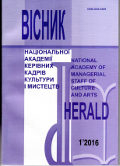MINIMAL MUSIC: BETWEEN THE EAST AND THE WEST
DOI:
https://doi.org/10.32461/2226-3209.1.2016.138485Keywords:
minimalism, minimalistic music, European music, non-western music,Abstract
The Minimal Art is the unique integrally formed artistic direction in postmodern polystylistic ramifyings. TheMinimal Art became a natural consequence of an evolutionary development of the world culture and the art in the 20thcentury as represents synthesis of traditions, а modern àvant-guard, and also the diffusion in it of the syncretism ofEuropean medieval and non-European cultures.
The experimental and classical periods of the American Minimal Music usually connect to creativity of the
composers John Cage, La Monte Young, Terry Riley, Steve Reich and Philip Glass.The understanding of the Minimal Music’s paradigm is offered as the initiative, preventive philosophy of a truesearch in which limits actually the philosophy is considered more likely as dialogue-interaction of the person with areality, instead of as polemical dialogue between supporters of the various dogmatic points of view. The priority of theMinimal Music existential display is proved as specificity, its dual essence in the decision composite minimaling’s acts ata hypertrophy of existential horizons which is shown first of all, at the "super-conciseness" of sounding volume, on theone hand, and in repetitive infinity of super-long soundings, in the other.
The American Mіnіmal Musіc is an objective music in that, since no physiological tension is created, there is anambiguous relationship with the listener. The music exists for itself and has nothing to do with the subjectivity of thelistener. The latter’s position has become an ambiguous one: on the one hand he is is freed of intentionality, but on theother hand he is reduced to a passive role, merely submitting to the process.
The determinative factor of the Minimal Art’s appearance was become the unique social and culturalcomposition of the American society, which appeared the result of coexistences of the traditional European culture,
actually American cultures (Irish-Catholic and English-Protestant "Yankee"), and also adopted cultural experience of Еastand African sources. An important value was here purchased by aesthetics of pragmatism, which transformed onnational ideology of country in the second half of 20th century. The world view of representatives of the AmericanMinimal Art, which got an academic university education mainly, was folded and under large influence of Europeanphilosophical studies of end of the 19th – 20th century (Adorno, Freud, Foucault, Derrida, Jung, Mach, Wittgenstein, andthe "Libidinal philosophy" of Deleuze and Lyotard). For example, considering the philosophical thinking of Deleuze andLyotard, the representatives of the so-called French "Libidinal Philosophy", and of Adorno, the author examines thedegree to which the "ecstatic dimension" is present in this music or is even consciously introduced into it.
The Mіnіmal Musіc ladled the traditions foremost in the West European music. It was showed in usage of elements of the medieval West-European polyphony, in particular the refined techniques of canonical structure of theNetherlands polyphonists’ motet. On the Mіnіmal Musіc influenced, on the one hand, the "experimental school" of JohnCage, with another – mass culture displays (a jazz, a rock-music and others like that).
The East culture with its philosophy of the Zen-Buddhism influenced on Mіnіmal Musіc’s becoming in merica(afterwards and in Europe) too. Definitely, the Mіnіmal Musіc is confluence of aesthetics of the East and the West. Forexample, the Zen-Buddhism helped minimalists to find in essence other perception of a sound material in which the greatvalue acquires not а result, and "a Music as a Gradual Process". The music is thus no longer related to a historicaldialecticalreality and loses its historical continuity. So it returns to non-Western forms that are then stripped of theirhistorical context and used as mere technical formulae and procedures.
There were three powerful centres which to the greatest degree affected musical language of minimalists:Indian, Balinese and West African music. In fact an ethnic music has itself had a strong influence on the works of theseAmerican composers: for Young, Riley and Glass the influence was that of the Indian music, while Reich has beeninfluenced by the West-African and Balinese music.
The using of technique of sounding of the non-Western music – contemplativeness, repetition, meditation, sounding endlessness etc. – foremost stipulates the opened form (process) and the open, static, taciturn (silence)temporal space. Often together with the term of "Mіnіmal Musіc" utilize a term "Meditative Music". The term "MeditativeMusic" too strictly refers to an extra-musical event and stresses that in American music a particular effect on the listeneris sought after. Indeed this may be correct, but it is too strong a devaluation of the music to suggest that it is merely apsychological instrument of influence.
The author of the article came to the conclusion, that the Mіnіmal Musіc as an appropriate phenomenon of postmodern art made the system of aesthetically-philosophical and technological principles, which, in the same time,appeared able to enter into synthetic relationships with other receptions of artistic creation and to generate the originalartistic world – "Confluence of aesthetics of the East and the West".
Downloads
Published
Issue
Section
License
Authors who publish with this journal agree to the following terms:
1. Authors retain copyright and grant the journal right of first publication with the work simultaneously licensed under a Creative Commons Attribution License International CC-BY that allows others to share the work with an acknowledgement of the work's authorship and initial publication in this journal.
2. Authors are able to enter into separate, additional contractual arrangements for the non-exclusive distribution of the journal's published version of the work (e.g., post it to an institutional repository or publish it in a book), with an acknowledgement of its initial publication in this journal.
3. Authors are permitted and encouraged to post their work online (e.g., in institutional repositories or on their website) prior to and during the submission process, as it can lead to productive exchanges, as well as earlier and greater citation of published work (See The Effect of Open Access).


